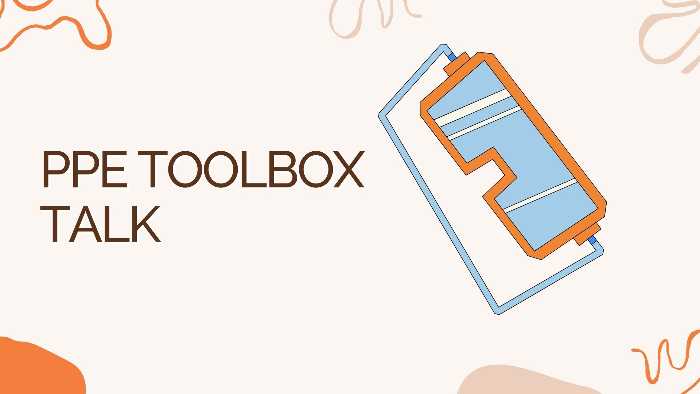PPE Toolbox Talk has always been delivered during toolbox meetings. Today this 5-minute talk is generally an aspect related to accident prevention that I try to emphasize to you. If we manage to implant some of these ideas in our minds and let them influence our way of acting, we will reduce to a minimum, where we work, the number of disabling injuries.
The human being learns "by blows". Children learn to walk by falling and bumping into each other. A country learns to dictate good laws after it has had to live under evil. The new and inexperienced worker learns the job from him by making mistakes.
There are teams to fight fires and watchmen. In the offices, there is a safe to protect money and documents. But many things have been designed to protect the worker, the worker only.
What has been said so far also applies to protective equipment. Behind every protective gear worn in this mine is a story of blood, pain, and death — that may not have happened here, but happened somewhere else. Let's take eye protection. For several centuries, workers in hundreds of different trades
suffered eye injuries. Thousands of workers lost their eyes from these injuries. These capable men, strong enough to work, became beggars as a result of accidents at work. The men tried to learn to do their jobs as safely as possible, but the eye injuries continued to happen.
For several decades at the beginning of the industrial age, many workers lost their sight, until finally, someone decided to invent protective eyewear to prevent these injuries. Some of you may have laughed at this inventor, but over the years it has been proven that workers who wear eye protection have far fewer eye injuries than those who don't.
The idea of protecting sight has become more and more ingrained and today there is a wide variety of eye protectors, each one designed to prevent injuries in certain jobs. This facial protection has been designed for one function only, to prevent any material from splashing on the worker's face causing injuries that can even leave him blind.
There is nothing automatic about personal protection. Only the user has to have awareness of the value of protecting both the eyes and the other parts of the body and, consequently, use the equipment provided for this purpose.
Human beings learn very slowly, but through the centuries they have learned a lot and we have the advantage of being able to learn from the mistakes made by others and not having to learn from our own.
We don't have to wait for a partner to lose his sight; too many have already lost it to wait for one more example to show us the need for protection. We can benefit without having to pay the price of suffering or even blindness. What we have said about eye protection also applies to safety shoes and helmets.
Thousands and thousands of crushed feet and shattered skulls have been the price paid by the human race to learn the need to protect themselves, both the head and the feet, and to know the different devices that provide that type of protection. The price paid has been quite high—what we have to do is receive the benefits.
What has been said about eye, head, and foot protection applies to any other personal protection that must be worn. Each one has been designed by people who have studied the problem and who have seen how many workers have been killed, maimed, or crippled in accidents.
These men are determined to stop the loss of human life and health. They have been concerned with testing the devices and improving them. They had to improve security equipment when someone paid with their blood and suffering.
When told to wear personal protective equipment, instead of complaining, be thankful that you have lived in an industrial age where every effort was made to protect the lives of workers, and that you work in an operation where management intends by all possible means that you always use the appropriate personal protection.
When workers are asked to wear personal protective equipment, they are not being asked to do the company a favor, they are only being asked to do themselves a favor. The workers can say that the company also benefits and it is true, but what the
company is trying to do is what is best for everyone, taking into account the welfare of the workers first. The efforts of any company will be null if the workers do not do something on their part to prevent an accident from leaving them blind, paralyzed, or even killed.
Management is always willing to help in many ways. The experience has taught them the kind of personal equipment that is necessary to use in different jobs and they will pass that experience on to the workers, who will have to learn to make good use of it.


